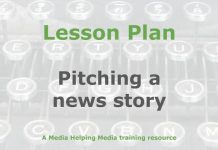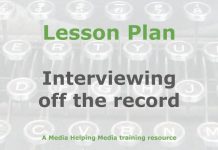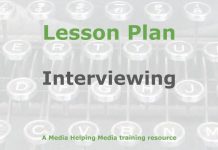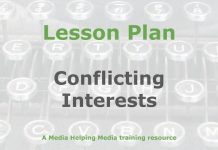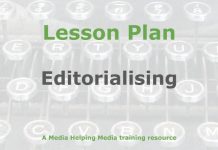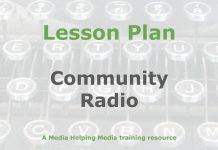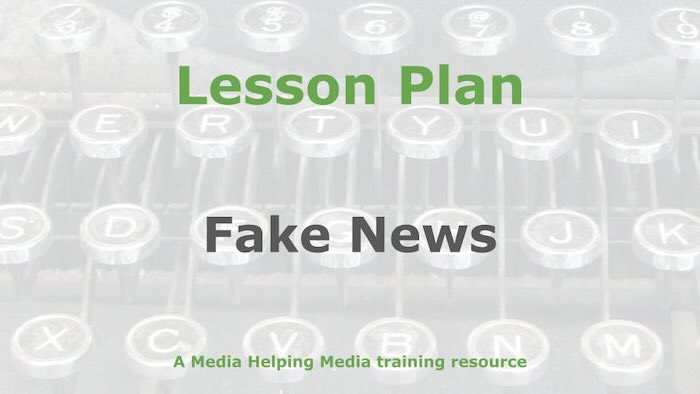 This lesson plan is designed to help journalists recognise the different types of ‘fake news’ and discover how to use ‘trust chains’ to deal with them.
This lesson plan is designed to help journalists recognise the different types of ‘fake news’ and discover how to use ‘trust chains’ to deal with them.
It’s based on the article ‘Fake news and trust chains‘ which we recommend trainers read before adapting this material for your own purposes.
Learning objective
Students will identify and categorise different types of fake news, including errors, satire, misinformation, and disinformation. They will also apply strategies to verify information and build trust chains in journalistic practice.
- Student-facing objective: By the end of this lesson the student will be able to spot different kinds of fake news and use techniques to check facts and build trust in their reporting.
- Standards: This lesson plan aims to help journalists recognise the types of fake news and how to deal with them.
Learning activities
Warm-up
Present students with four brief news headlines. Ask, “Which one doesn’t belong?” Ensure each headline is distinct in its nature: one could be an error, another satire, a third misinformation, and the last disinformation. Allow students a few minutes to think and then discuss with a partner. Prompt them to explain their reasoning for identifying the outlier. Conclude by highlighting the differences between the types of fake news, setting the stage for deeper exploration in the lesson.
Direct instruction
Conceptual understanding: Begin with a brief lecture on the evolution of “fake news.” Explain the distinction between fabricated stories and the dismissal of legitimate news. Use historical examples, such as propaganda in wartime, to illustrate how misinformation has been used. Highlight the recent rise of “fake news” as a tool to undermine credible sources.
Procedural skills and fluency: Introduce the types of fake news: errors, satire, misinformation, and disinformation. Provide real-world examples for each type. For instance, show a satirical article from a known humor site and a misinformation piece that selectively quotes facts. Discuss the motivations behind each type and how they can impact public perception.
Application: Explain the concept of a “trust chain” in journalism. Break down the steps: self-awareness, transparent reporting, critical evaluation, source verification, fact vs. opinion, reliable sources, cross-verification, internet caution, and diverse perspectives. Use a current news story and walk through the process of verifying its credibility, demonstrating each step of the trust chain.
Guided practice
Think, Pair, Share: Distribute a set of news articles to each student, ensuring a mix of errors, satire, misinformation, and disinformation.
- Think: Ask students to individually read and identify the type of fake news in each article, noting their reasoning.
- Pair: Have students pair up to discuss their findings, encouraging them to challenge each other’s classifications and reasoning.
- Share: Facilitate a class discussion where pairs share their insights. Encourage students to explain their thought process and how they applied the trust chain principles.
- Reflect: Conclude with a reflection on how these skills can be applied in real-world journalism to maintain credibility and trust.
Independent practice
- Assign students an exercise to identify and categorise types of fake news from a curated list of articles. Include a mix of errors, satire, misinformation, and disinformation.
- Instruct students to apply the trust chain principles to verify the credibility of each article. Encourage them to document their process and findings.
- Circulate to observe and support students, ensuring they understand how to differentiate between types of fake news and apply verification strategies effectively.
Assignment
Ask these questions:
- How can you differentiate between misinformation and disinformation?
- What is one step in the “trust chain” that you find most crucial, and why?
- What’s one question you still have from today’s lesson?
Suggested answers:
- Suggested answer to Question 1: Misinformation involves unintentional inaccuracies, while disinformation is deliberately deceptive.
- Suggested answer to Question 2: Source verification is crucial because it ensures the information’s origin is reliable.
Teacher resources
Differentiation guide
- Advanced learners: Encourage deeper analysis by having students explore the motivations behind fake news. Assign a research task on the historical use of misinformation in different cultures or political contexts. Challenge them to create a presentation on how these tactics have evolved with technology.
- Striving learners: Simplify the lesson by focusing on fewer types of fake news. Use clear, relatable examples. Provide graphic organisers to help them categorise and differentiate between types. Offer additional support during the “trust chain” activity by guiding them through each step with structured prompts.
- Background reading: This lesson plan is based on the article ‘Fake news and trust chains‘ which we recommend trainers read before adapting this material for your own purposes.
Notable definitions
- Fake news: Fabricated stories presented as truth, or the dismissal of legitimate news as false to discredit unfavourable reporting.
- Misinformation: The spread of false or misleading information without malicious intent, often due to errors or misunderstandings.
- Disinformation: Deliberate creation and dissemination of false information with the intent to deceive and manipulate public perception.
Required materials
- News articles (mix of errors, satire, misinformation, disinformation)
- Printed copies of a curated list of articles for independent practice
- Access to computers or tablets for online research and verification
- Projector for displaying headlines and examples
- Whiteboard and markers for class discussion and notes
Lesson summary
- Warm-up
- Direct instruction
- Guided practice
- Independent practice
- Assignment
The free teaching tools at the Khan Academy were used in the production of this lesson plan.
